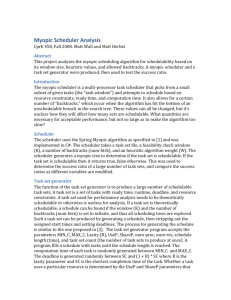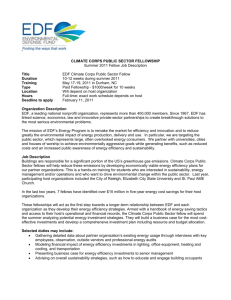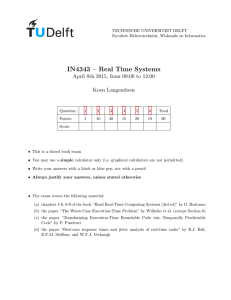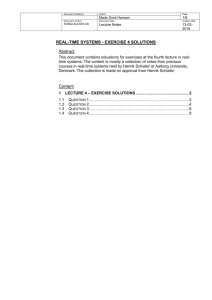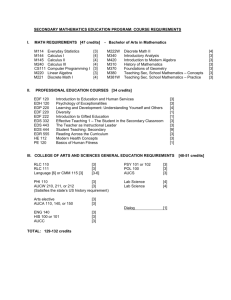Answers
advertisement
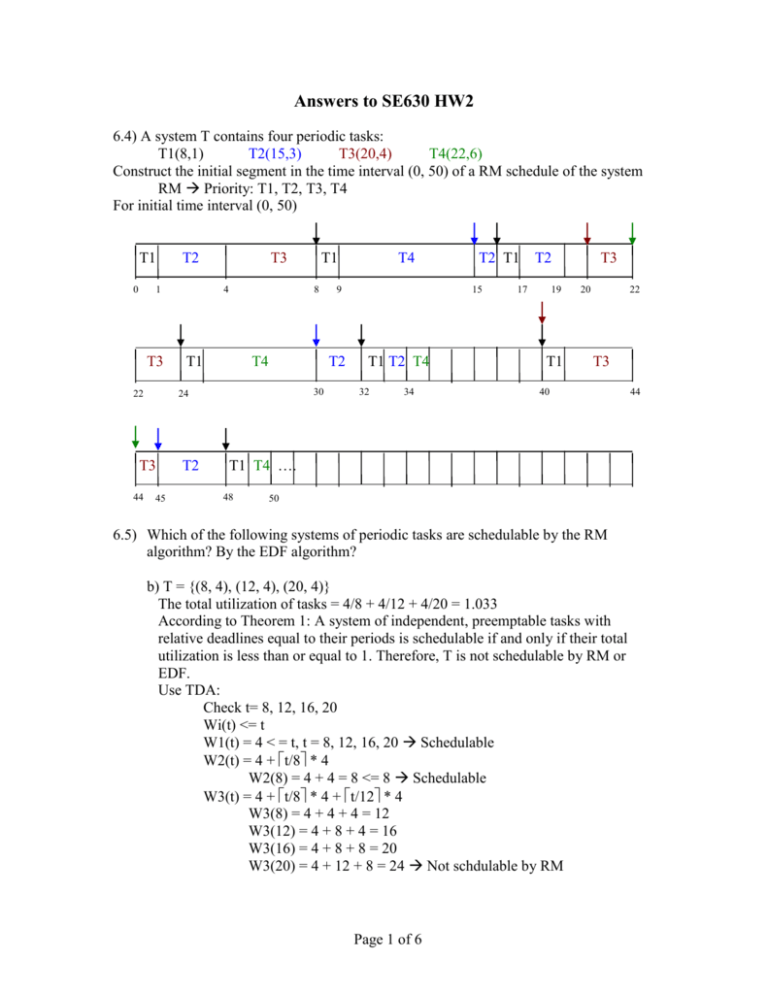
Answers to SE630 HW2
6.4) A system T contains four periodic tasks:
T1(8,1)
T2(15,3)
T3(20,4)
T4(22,6)
Construct the initial segment in the time interval (0, 50) of a RM schedule of the system
RM Priority: T1, T2, T3, T4
For initial time interval (0, 50)
T1
0
T2
1
T3
22
4
T1
45
T2
T1
8
T4
30
T4
9
T2
24
T3
44
T3
T2 T1 T2
15
T1 T2 T4
32
34
17
19
T1
T3
20
22
T3
40
T1 T4 ….
48
50
6.5) Which of the following systems of periodic tasks are schedulable by the RM
algorithm? By the EDF algorithm?
b) T = {(8, 4), (12, 4), (20, 4)}
The total utilization of tasks = 4/8 + 4/12 + 4/20 = 1.033
According to Theorem 1: A system of independent, preemptable tasks with
relative deadlines equal to their periods is schedulable if and only if their total
utilization is less than or equal to 1. Therefore, T is not schedulable by RM or
EDF.
Use TDA:
Check t= 8, 12, 16, 20
Wi(t) <= t
W1(t) = 4 < = t, t = 8, 12, 16, 20 Schedulable
W2(t) = 4 + t/8 * 4
W2(8) = 4 + 4 = 8 <= 8 Schedulable
W3(t) = 4 + t/8 * 4 + t/12 * 4
W3(8) = 4 + 4 + 4 = 12
W3(12) = 4 + 8 + 4 = 16
W3(16) = 4 + 8 + 8 = 20
W3(20) = 4 + 12 + 8 = 24 Not schdulable by RM
Page 1 of 6
44
Schedulability test of EDF algorithm: Since Dk = Pk, U = 1.033 >1 therefore, it is
not schedulable by EDF.
c) T = {(8, 4), (10, 2), (12, 3)}
The total utilization of tasks = 4/8 + 2/10 + 3/12 = 0.95
For RM:
These are not simply periodic tasks, so Theorem 3 does not apply. Exam by using
sufficient schedulability: The tasks are schedulable if the total utilization of tasks,
U, is less or equal to n(n^(1/n)-1), where n is the number of tasks.
Urm = n(n^(1/n)-1) = 3(2^(1/3)-1) = 0.78 < U = 0.95
No conclusion.
Use TDA:
Check t = 8, 10, 12
Wi(t) <= t
W1(t) = 4 < = t, t =8, 10, 12 Schedulable
W2(t) = 2 + t/84
W2(8) = 2 + 4 = 6 <= 8 Schedulable
W3(t) = 3 + t/84 + t/102
W3(8) = 3 + 4 + 2 = 9
W3(10) = 3 + 8 + 2 = 13
W3(12) = 3 + 8 + 4 = 15 Not schedulable
Try to plot:
T1
2
T2
4
T3
6
8
Therefore, it is not schedulable by using RM.
T1
10
12
14
T3 misses its
deadline
For EDF:
According to the schedulability Test for EDF algorithm:
n
e / min( Dk , pk ) 1
k 1 k
In the case that Dk = Pk, the expression represents the total utilization of the
tasks, which we have calculated. U = 0.95 less than one. Therefore, the periodic
tasks are schedulable by EDF algorithm.
Page 2 of 6
6.9)
Periodic Tasks: (3,1), (4,2), (6,1) are scheduled by RM algorithm
a) Draw Time Demand Function of the tasks
w3(t)
w(t)
w2(t)
w1(t)
2
4
6
8
10
12
14
t
b) Are the tasks schedulable?
No. Based on the Time Demand Function graph, Task 3 did not touch or
go below the dash line by its deadline at time 6. In another word, it can not
meet its deadline and therefore not schedulable.
c) Can this graph be used to determine whether the tasks are schedulable
according to an arbitrary priority-driven algorithm?
No. This graph is fundamentally based on fixed priority driven algorithm
which assigns the same priority to all jobs in each task. In the graph, T2 is
built on top of T1 since all jobs in T1 have a higher priority than all jobs in
T2. T3 is built on top of T1 and T2since all jobs in T1 and T2 have a
higher priority than all jobs in T3. This graph does not depict dynamic
priority driven algorithm, such as earliest deadline first (EDF). In EDF,
any job in a task can have a higher priority at a specific moment
depending on its deadline compared to the jobs of other tasks. Therefore,
this graph cannot be used to determine the schedulability of an arbitrary
priority-driven algorithm.
Page 3 of 6
6.10) Which of the following fixed-priority task is not schedulable?
T1(5,1)
T2(3,1)
T3(7,2.5)
T4(16,1)
t
wi (t ) ei ek
k 1 pk
i1
If Wi(t) <= t, the task is schedulable.
Assume RM/DM scheduling algorithm is used. Priority: T2>T1>T3>T4
Index, i, is assigned to each task according to its priority.
T2: i = 1, T1: i = 2, T3: i = 3., T4: i = 4
Check: t = 3, 5, 6, 7, 9, 10, 12, 14, 15, 16
W1(t) = 1 < t, t= 3, 5, 6, 7, 9, 10, 12, 14, 15, 16 Schedulable
W2(t) = 1 + t/3
W2(3) = 1+1 = 2 <=3 Schedulable
W3(t) = 2.5 + t/3 + t/5 (check: 2.5+1+1=4.5 min t =5)
W3(5) = 2.5+2+1 = 5.5
W3(6) = 2.5+2+2 = 6.5
W3(7) = 2.5+3+2 = 7.5 Miss its deadline, 7, so Not Schedulable
W4(t) = 1 + t/3 + t/5 + 2.5t/7 (check: 1+1+1+2.5=5.5 min t =6)
W4(6) = 1+2+2+2.5 = 7.5
W4(7) = 1+3+2+2.5 = 8.5
W4(9) = 1+3+2+5 = 11
W4(10) = 1+4+2+5 = 12
W4(12) = 1+4+3+5 = 13
W4(14) = 1+5+3+5 = 14 <= 14 Schedulable
T3 is not a schedulable task
Page 4 of 6
6.21)
(A) Use the time-demand analysis method to show that the set of periodic tasks
{(5,1),(8,2),(14,4)} is schedulable according to the RM algorithm.
t
wi (t ) ei ek
k 1 pk
i1
Check: t = 5, 8, 10, 14
W1(t) = 1 <= t, for t = 5, 8, 10, 14 Schedulable
W2(t) = 2 + t/5
W2(5) = 2+1 =3 <= 5 Schedulable
W3(t) = 4 + t/5 + 2t/8 (check: min t = 4+1+2=7)
W3(8) = 4+2+2 = 8 <= 8 Schedulable
(B) Suppose that we want to make the first x units of each request in the task (8,2)
nonpreemptable. What is the maximum value of x so that the system remains
schedulable according to the rate-monotonic algorithm?
Answer 1:
T={(5,1)(8,2)(14,4)}
T1=(5,1)
T1 T2
0
1 2
T2 T1
T2=(8,2)
T3
3
4
T3
T3=(14,4) (in order of priority, T1 being highest)
T1 T3
5
6
7
T2
T1
T3 T1 T2
T3
T1 T3
T2
8 9 10 11 12 13 14 15 16 17 18 19 20 21 22 23 24
T1 T3 T2
T3 T1
T1 T2
T3
T1 T3
T2
25 26 27 28 29 30 31 32 33 34 35 36 37 38 39 40 41 42 43 44 45 46 47 48 49 50
T1 has a higher priority than T2 but a higher priority job that becomes ready when a
nonpreemptable lower-priority jobs is executing is blocked until the nonpreemptable portion of
the lower priority job completes. Therefore T1 will be blocked until T2 completes.
T2 (8, 2) can be made nonpreemptable for the first 2 time units (its entire
duration) and still allow the system to be scheduled on time.
Page 5 of 6
Answer 2:
If we make the first x units of Task (8, 2) nonpreemptable: T3 is unaffected by this
change since T2 is a higher priority task anyway. T2 is also unaffected. Its response
time will not be affected by the change (if anything it would improve)
W1= x+1 <=5, x<=4
x can be at most 4 time units. But since Task 2 (8, 2), only has an execution time of 2
time units, x can be 2 time units.
Page 6 of 6
